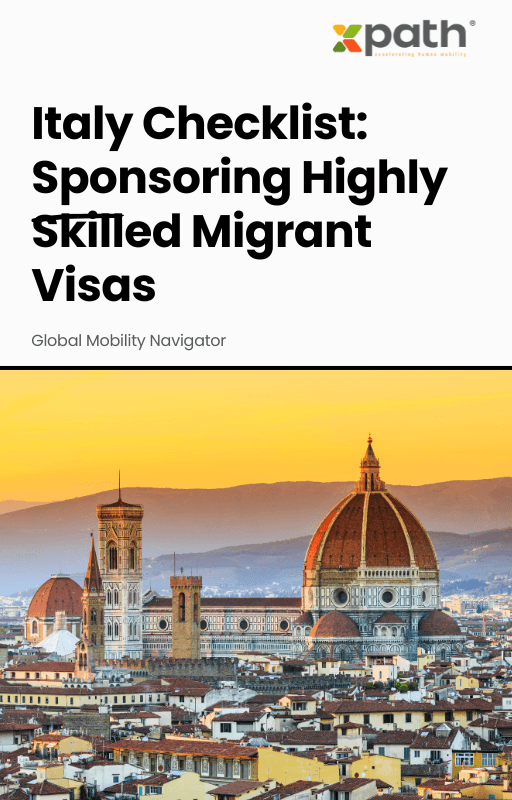Italy Checklist: Sponsoring Highly Skilled Migrant Visas
Grab a copy of a guide to international employee relocation
View E-bookIn today’s ever-evolving business landscape, global mobility has never been more critical—nor more complicated. With companies deploying talent across continents at unprecedented rates, the challenge of efficiently managing and centralizing global mobility data is more pressing than ever. As organizations expand their international footprint, the need to unify data streams across teams, countries, and external vendors isn’t merely an operational nice-to-have; it’s a competitive must-have. So, how do leading companies achieve this seamless integration, and what can you do to join them?
Let’s zoom out for a moment. Global mobility—the management of employee relocation, assignments, and compliance across borders—has exploded in scale and complexity. Per Deloitte’s 2023 Global Mobility Trends report, 79% of organizations expect international assignments to increase in the coming years. Fueled by digital transformation and remote work, companies are tackling multiple time zones, tax regimes, and regulatory requirements—with data often trapped in silos across HR departments, destination services, and payroll providers. Without centralization, tracking program costs, employee experience, and compliance morphs into a logistical nightmare.
Imagine trying to conduct an orchestra where each section has its own sheet music—chaos, right? That’s what many organizations face with fragmented mobility data. Centralizing global mobility data brings harmony by enabling:
Without a centralized approach, organizations risk errors, compliance breaches, and missed opportunities for cost optimization and talent retention.
Here’s where the plot thickens. In a 2022 EY survey, 60% of mobility leaders cited data fragmentation as their biggest challenge. Traditional mobility programs juggle multiple data sources—spreadsheets in HR, immigration tracking systems, expense reports from vendors, and more. Each team or vendor manages their own data, often in incompatible formats and platforms. Throw in differing privacy regulations like GDPR, and you have a recipe for inefficiency and risk. Employees feel the pain through disjointed communication and inconsistent support, while mobility managers struggle for a clear program overview.
What are top-performing companies doing differently? The answer lies in embracing centralized, technology-driven solutions. Platforms like xpath.global are transforming the industry by aggregating all key mobility data—assignments, costs, compliance documents, employee feedback—into one secure, accessible dashboard.
Consider the case of a multinational conglomerate that adopted a centralized mobility management system. Within six months, they reduced assignment processing times by 31% and identified over $500,000 in redundant vendor fees. A Gartner study found that organizations using centralized dashboards saw full program visibility increase by 45%, leading to faster decision-making and improved employee satisfaction scores.
So, what’s the magic formula? Integrated platforms connect HR, payroll, tax, vendors, and relocation providers; automate compliance workflows; support global reporting standards; and ensure data privacy. These systems allow stakeholders to collaborate in real-time and provide leadership with actionable analytics on every move.
You don’t need to reinvent the wheel. Begin by auditing your current data flows: where does data reside, who manages it, and how often is it updated? Identify all teams—internal and external—touching mobility processes. Next, define your requirements for integration: Do you need multilingual support? Automated document management? Real-time alerts?
Invest in a platform (like xpath.global) that can connect disparate systems via robust APIs and secure cloud storage, ensuring global accessibility and compliance. Ensure stakeholder buy-in—with education on how streamlined data benefits them, from HR teams to business travelers.
Finally, implement a change management strategy. Centralization isn’t just tech—it’s about aligning cultures and establishing clear data governance. Assign data stewards, set audit protocols, and establish regular reviews to maintain data quality and security across all locations and vendors.
The race toward mobility centralization is only gaining momentum. Automation, artificial intelligence, and predictive analytics will increasingly drive the next generation of global mobility solutions. According to the 2024 Worldwide ERC report, organizations that leverage integrated mobility data are 22% more likely to meet compliance obligations and offer tailored employee experiences. In this new world, those left relying on scattered spreadsheets or manual processes will find themselves outpaced, both operationally and strategically.
1. What is a global mobility solution?
A global mobility solution is a combination of technology and services that enables companies to manage international employee relocations, assignments, and compliance across multiple jurisdictions, vendors, and teams.
2. What problems does data centralization solve in global mobility?
It eliminates data silos, improves program visibility, ensures compliance, reduces errors, and streamlines communication between all stakeholders—leading to faster, more cost-effective, and employee-friendly relocations.
3. How does xpath.global support centralized global mobility data?
xpath.global delivers a cloud-based platform that aggregates all relocation information, transactions, and communications in one secure place, integrating with HR systems and vendors worldwide for seamless data management and compliance.
4. What should I look for in a global mobility data solution?
Key features include API integration, cloud access, robust analytics, compliance tracking, user-friendly interfaces, and strong security protocols.
5. How do I start centralizing my mobility data?
Begin with a data audit, consolidate vendors, select a scalable platform like xpath.global, and bring stakeholders together around a clear data governance strategy.
Ready to transform your mobility program? Explore xpath.global’s solutions.

Italy Checklist: Sponsoring Highly Skilled Migrant Visas
Grab a copy of a guide to international employee relocation
View E-book